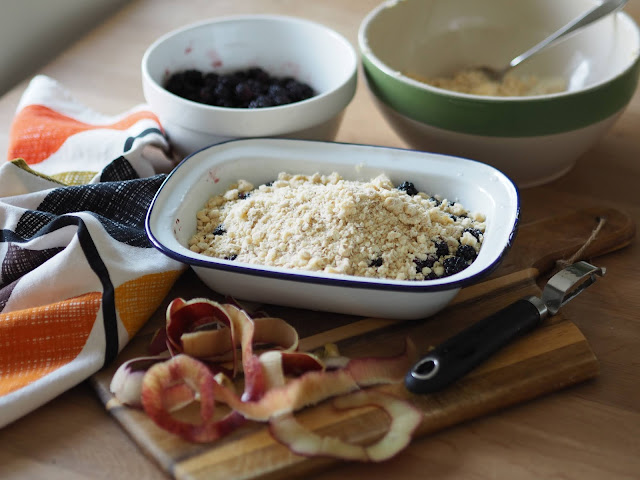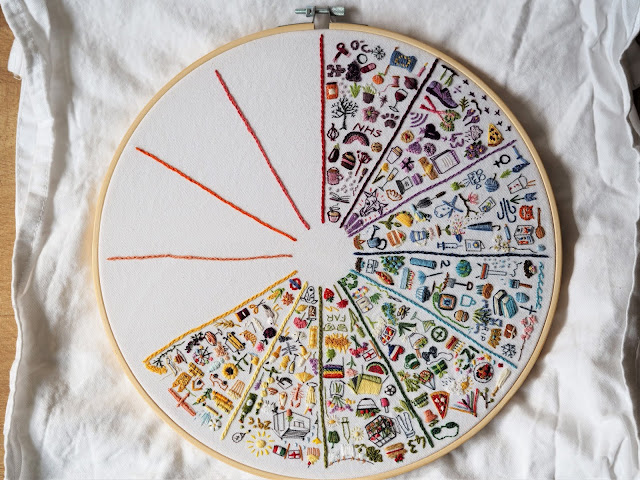
At the end of the summer holidays, I spent a very happy couple of weeks cooking my way through a beautiful cookery book: The Little Library Cookbook: 100 recipes from our favourite stories by Kate Young. It is a lovely book, full of recipes inspired by fictional meals in literature, some famous, some not so much. I love both cooking and reading - my favourite part of any book is when the author describes what the characters are eating - and I knew I would like this book, and I did. It would make a really good gift for anyone who enjoys both reading and pottering in the kitchen.
The book itself is arranged loosely around meal times and types, but with extra chapters tantalisingly entitled "midnight feasts" and "parties and celebrations".
I worked my way through the book, trying to cook something from every chapter, although I didn't have much use for the Christmas or party food section in August. As ever, I am hoping for more ideas for everyday weeknight dinners, always the element of cooking that I least enjoy.
I began with the chapter "before noon", containing delights such as marmalade (Paddington), pancakes (Pippi Longstocking), baked beans (Little House on the Prairie) and cold apple pie (The Railway Children). I chose Green Eggs and Ham (Dr Seuss, of course) which is basically pesto scrambled eggs on toast with ham.
Now, I love pesto and I love scrambled eggs, but I have never thought to put them together. I made parsley pesto (parsley, parmesan, oil, garlic and almonds) and stirred this into the eggs just before they were cooked.
What a revelation! The result looks a lot like avocado, but with a million times more flavour. It is completely delicious, and a really easy way to add something to simple scrambled eggs on toast. Definitely something to make again.
From the afternoon tea chapter, I could have made every recipe. I enjoyed trying these Anzac cookies, a cross between flapjacks and cookies, chewy with oats and coconut. They were perfect for mid-morning or afternoon snacks with a tea or coffee and kept really well in the tin for ages. (Inspired by the book Possum Magic by Mem Fox, these cookies are well known and were originally made and sent to the Australian and New Zealand Army Corps, or Anzacs, during the First and Second World Wars. Kate Young lives in the UK now but grew up in Australia, hence the connection.)
I tried hunny and rosemary cakes (Winnie-the-Pooh), which were rather grown-up cupcakes, made with dark brown sugar, honey and chopped rosemary, before being finished with a cream cheese frosting.
Next time I would line the muffin tin with cupcake cases though, as despite greasing and flouring the tin, they did require a bit of persuasion to leave the tin in one piece.
I definitely had to try the madeleines (In Search of Lost Time by Proust, who else?), if only to get out my not-much-used madeleine tin.
Madeleines are tiny sponge cakes with a crispy shell and soft sponge. You have to chill the batter for a couple of hours with madeleines - to help the sponge rise into the little peak I believe - but otherwise they are very easy to make and even easier to eat.
From the dinner table chapter, we tried lots of things. There was "a fine curry", (Vanity Fair) for which we substituted the goat for lamb.
I like my curries to have a little more punch and flavour than this one, which felt more like a spiced stew. However, the kids really loved it.
We tried spaghetti and meatballs (The Godfather) which I knew we would all like but I was curious to try a different recipe. These involved making meatballs from scratch before lightly rolling them in flour and chilling them in the fridge. Normally I buy a pack of ready made ones from the supermarket and make my own sauce.
You fry them, remove them while you make the tomato sauce, then add them back in to simmer while the spaghetti is cooking.
There was something mindful and enjoyable about making the meatballs from scratch, rolling the balls in my hands, lining them all up on the baking tray. Nice cooking to do on a weekend afternoon when you're not in a hurry.
We tried spanakopita (from Middlesex by Jeffrey Eugenides). This involved emptying a 1 kg bag of frozen spinach into a pan and frying until it's all hot and you've removed as much water as possible. After that you drain it in a sieve and it's amazing how much more liquid keeps appearing as you squeeze the mixture. Once it's as water-free as possible (to avoid soggy pastry) you add the feta cheese. I could have just eaten this mixture from the bowl as it was.

Spanakopita requires filo pastry which I don't use much because, I don't know, I just think puff or shortcrust are nicer. But I layered my shop-bought sheets with melted butter and filled it with spinach, and tried to roll it up into a coil, as per the recipe, but it broke into two big sausage shapes. I decided to bake them like that and they were really good despite the unappealing presentation. John and I shared half each of the smaller pie for dinner with some salad, and the larger one I chopped into pieces which I then ate for lunch and it was still delicious. I would add more feta next time though.
From the chapter entitled "midnight feasts" we tried sausage rolls and ramen, neither of which we ate at midnight. The sausage rolls (from Harry Potter and the Goblet of Fire) were really good and very easy, simply a well seasoned and flavoured mixture of sausage meat, pork mince and vegetables inside puff pastry. Easy to make, fun to assemble with the children, and easy to eat for lunch. Good hot and cold.
We had to try the ramen recipe (inspired by Kitchen by Banana Yoshimoto) because Bella is obsessed with ramen and would eat it every night for dinner. I have never gotten near creating a ramen stock as flavourful as one I have eaten in a restaurant, so don't make it very often.
This was one of the best recipes I've tried though - I think it was the addition of shitake mushrooms to the stock - and completely, wonderfully delicious. Angus doesn't really enjoy ramen ("I can't tell if it's a stir fry or a soup!") so I tend to serve his with hardly any stock, but the rest of us loved it. I also need to invest in some proper ramen bowls and spoons, as pasta bowls and soup spoons don't really work that well.
So, altogether, a delightful book which is as lovely to cook from as it is to simply read in bed. It had the added bonus of making me think about books I hadn't done for a long time, such as Kitchen by Japanese author Banana Yoshimoto. I loved this book when I read it twenty years ago, and have a few of hers, and think it's time for a re-read. Plus all the hundreds of books out there which I really want to read at some point, old and new. I would love to know if you have any favourite food-related fiction books or authors you would recommend.





























































